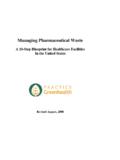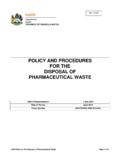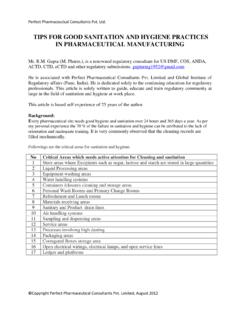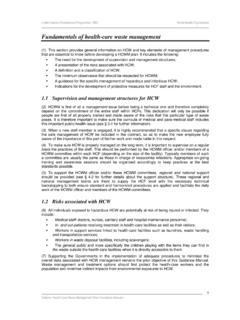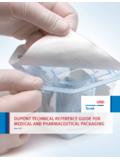Transcription of 3 Health impacts of health-care waste - WHO
1 Safe management of wastes from Health - care activities 3 Health impacts of Health - care waste Hazards of Health - care waste Health - care waste includes a large component of general waste and a smaller proportion of hazardous waste . This chapter addresses the poten- tial hazards of exposure to hazardous (or risk) Health - care waste . Types of hazards Exposure to hazardous Health - care waste can result in disease or injury. The hazardous nature of Health - care waste may be due to one or more of the following characteristics: it contains infectious agents;. it is genotoxic;. it contains toxic or hazardous chemicals or pharmaceuticals;. it is radioactive;. it contains sharps. Persons at risk All individuals exposed to hazardous Health - care waste are potentially at risk, including those within Health - care establishments that generate hazardous waste , and those outside these sources who either handle such waste or are exposed to it as a consequence of careless management. The main groups at risk are the following: medical doctors, nurses, Health - care auxiliaries, and hospital mainte- nance personnel.
2 Patients in Health - care establishments or receiving home care ;. visitors to Health - care establishments;. workers in support services allied to Health - care establishments, such as laundries, waste handling, and transportation;. workers in waste disposal facilities (such as landfills or incinerators), including scavengers. The hazards associated with scattered, small sources of Health - care waste should not be overlooked; waste from these sources includes that generated by home-based Health care , such as dialysis, and that gener- ated by illicit drug use (usually intravenous). Hazards from infectious waste and sharps Infectious waste may contain any of a great variety of pathogenic micro- organisms. Pathogens in infectious waste may enter the human body by a number of routes: 20. Health impacts of Health - care waste through a puncture, abrasion, or cut in the skin;. through the mucous membranes;. by inhalation;. by ingestion. Examples of infections that can be caused by exposure to Health - care waste are listed in Table , together with the body fluids that are the usual vehicles of transmission.
3 There is particular concern about infection with human immunodeficien- cy virus (HIV) and hepatitis viruses B and C, for which there is strong evidence of transmission via Health - care waste . These viruses are gener- ally transmitted through injuries from syringe needles contaminated by human blood. The existence in Health - care establishments of bacteria resistant to anti- biotics and chemical disinfectants may also contribute to the hazards created by poorly managed Health - care waste . It has been demonstrated, for example, that plasmids from laboratory strains contained in Health - care waste were transferred to indigenous bacteria via the waste disposal system. Moreover, antibiotic-resistant Escherichia coli have been shown to survive in an activated sludge plant, although there does not seem to be significant transfer of this organism under normal conditions of waste - water disposal and treatment. Concentrated cultures of pathogens and contaminated sharps (particu- larly hypodermic needles) are probably the waste items that represent the most acute potential hazards to Health .
4 Sharps may not only cause cuts and punctures but also infect these wounds if they are contaminated with pathogens. Because of this double risk of injury and disease transmission sharps are considered as a Table Examples of infections caused by exposure to Health - care wastes, causative organisms, and transmission vehicles Type of infection Examples of causative organisms Transmission vehicles Gastroenteric infections Enterobacteria, Salmonella, Shigella spp.; Faeces and/or vomit Vibrio cholerae; helminths Respiratory infections Mycobacterium tuberculosis; measles virus; Inhaled secretions; saliva Streptococcus pneumoniae Ocular infection Herpesvirus Eye secretions Genital infections Neisseria gonorrhoeae; herpesvirus Genital secretions Skin infections Streptococcus spp. Pus Anthrax Bacillus anthracis Skin secretions Meningitis Neisseria meningitidis Cerebrospinal fluid Acquired immunodeficiency Human immunodeficiency virus (HIV) Blood, sexual secretions syndrome (AIDS).
5 Haemorrhagic fevers Junin, Lassa, Ebola, and Marburg viruses All bloody products and secretions Septicaemia Staphylococcus spp. Blood Bacteraemia Coagulase-negative Staphylococcus spp.;. Staphylococcus aureus; Enterobacter, Enterococcus, Klebsiella, and Streptococcus spp. Candidaemia Candida albicans Blood Viral hepatitis A Hepatitis A virus Faeces Viral hepatitis B and C Hepatitis B and C viruses Blood and body fluids 21. Safe management of wastes from Health - care activities very hazardous waste class. The principal concerns are infections that may be transmitted by subcutaneous introduction of the causative agent, viral blood infections. Hypodermic needles constitute an important part of the sharps waste category and are particularly hazardous because they are often contaminated with patients' blood. Hazards from chemical and pharmaceutical waste Many of the chemicals and pharmaceuticals used in Health - care estab- lishments are hazardous ( toxic, genotoxic, corrosive, flammable, reactive, explosive, shock-sensitive).
6 These substances are commonly present in small quantities in Health - care waste ; larger quantities may be found when unwanted or outdated chemicals and pharmaceuticals are disposed of. They may cause intoxication, either by acute or by chronic exposure, and injuries, including burns. Intoxication can result from absorption of a chemical or pharmaceutical through the skin or the mucous membranes, or from inhalation or ingestion. Injuries to the skin, the eyes, or the mucous membranes of the airways can be caused by contact with flammable, corrosive, or reactive chemicals ( formal- dehyde and other volatile substances). The most common injuries are burns. Disinfectants are particularly important members of this group: they are used in large quantities and are often corrosive. It should also be noted that reactive chemicals may form highly toxic secondary compounds. Obsolete pesticides, stored in leaking drums or torn bags, can directly or indirectly affect the Health of anyone who comes into contact with them.
7 During heavy rains, leaked pesticides can seep into the ground and contaminate the groundwater. Poisoning can occur through direct contact with the product, inhalation of vapours, drinking of contami- nated water, or eating of contaminated food. Other hazards may include the possibility of fire and contamination as a result of inadequate dis- posal such as burning or burying. Chemical residues discharged into the sewerage system may have adverse effects on the operation of biological sewage treatment plants or toxic effects on the natural ecosystems of receiving waters. Similar prob- lems may be caused by pharmaceutical residues, which may include antibiotics and other drugs, heavy metals such as mercury, phenols, and derivatives, and disinfectants and antiseptics. Hazards from genotoxic waste The severity of the hazards for Health - care workers responsible for the handling or disposal of genotoxic waste is governed by a combination of the substance toxicity itself and the extent and duration of exposure.
8 Exposure to genotoxic substances in Health care may also occur during the preparation of or treatment with particular drugs or chemicals. The main pathways of exposure are inhalation of dust or aerosols, absorption through the skin, ingestion of food accidentally contaminated with cyto- toxic drugs, chemicals, or waste , and ingestion as a result of bad practice, such as mouth pipetting. Exposure may also occur through contact with the bodily fluids and secretions of patients undergoing chemotherapy. The cytotoxicity of many antineoplastic drugs is cell-cycle-specific, targeted on specific intracellular processes such as DNA synthesis and 22. Health impacts of Health - care waste mitosis. Other antineoplastics, such as alkylating agents, are not phase- specific, but cytotoxic at any point in the cell cycle. Experimental studies have shown that many antineoplastic drugs are carcinogenic and mu- tagenic; secondary neoplasia (occurring after the original cancer has been eradicated) is known to be associated with some forms of chemotherapy.
9 Many cytotoxic drugs are extremely irritant and have harmful local effects after direct contact with skin or eyes (Box ). They may also cause dizziness, nausea, headache, or dermatitis. Additional information on Health hazards from cytotoxic drugs may be obtained on request from the International Agency for Research on Cancer (IARC).1. Special care in handling genotoxic waste is absolutely essential; any discharge of such waste into the environment could have disastrous ecological consequences. Radioactive waste is dealt with separately, in section Hazards from radioactive waste The type of disease caused by radioactive waste is determined by the type and extent of exposure. It can range from headache, dizziness, and vomiting to much more serious problems. Because radioactive waste , like certain pharmaceutical waste , is genotoxic, it may also affect genetic material. Handling of highly active sources, certain sealed sources from diagnostic instruments, may cause much more severe injuries (such Box Cytotoxic drugs hazardous to eyes and skin Alkylating agents Vesicant1 drugs: aclarubicin, chlormethine, cisplatin, mitomycin Irritant drugs: carmustine, cyclophosphamide, dacarbazine, ifosfamide, melphalan, streptozocin, thiotepa Intercalating agents Vesicant drugs: amsacrine, dactinomycin, daunorubicin, doxorubicin, epirubicin, pirarubicin, zorubicin Irritant drugs: mitoxantrone Vinca alkaloids and derivatives Vesicant drugs: vinblastine, vincristine, vindesine, vinorelbine Epipodophyllotoxins Irritant drugs: teniposide 1.)
10 Blistering. 1. International Agency for Research on Cancer, Unit of Gene Environment Interactions, 150 Cours Albert-Thomas, 69372 Lyon Cedex 08, France. 23. Safe management of wastes from Health - care activities as destruction of tissue, necessitating amputation of body parts) and should therefore be undertaken with the utmost care . The hazards of low-activity waste may arise from contamination of exter- nal surfaces of containers or improper mode or duration of waste storage. Health - care workers or waste -handling or cleaning personnel exposed to this radioactivity are at risk. Public sensitivity Quite apart from fear of Health hazards, the general public is very sensitive about the visual impact of anatomical waste , that is recog- nisable human body parts, including fetuses. In no circumstances is it acceptable to dispose of anatomical waste inappropriately, such as on a landfill. In some cultures, especially in Asia, religious beliefs require that human body parts be returned to a patient's family, in tiny coffins, to be buried in cemeteries.










